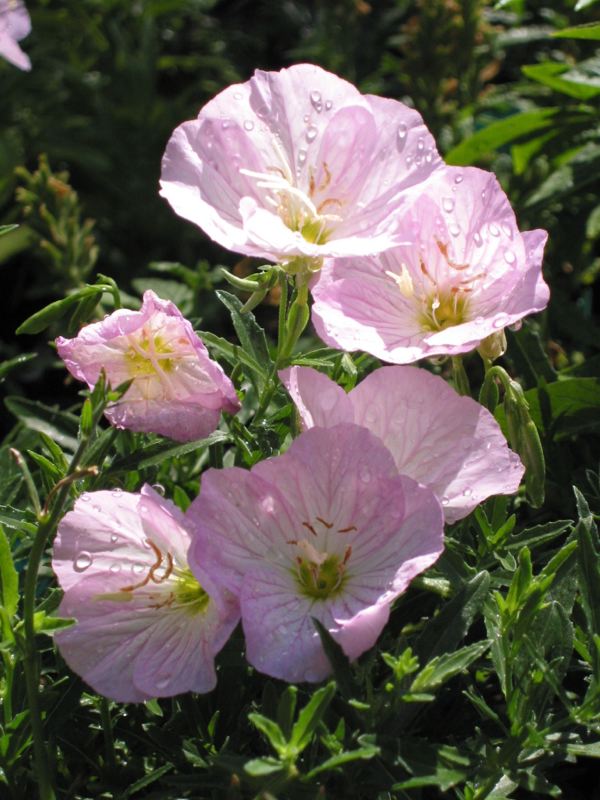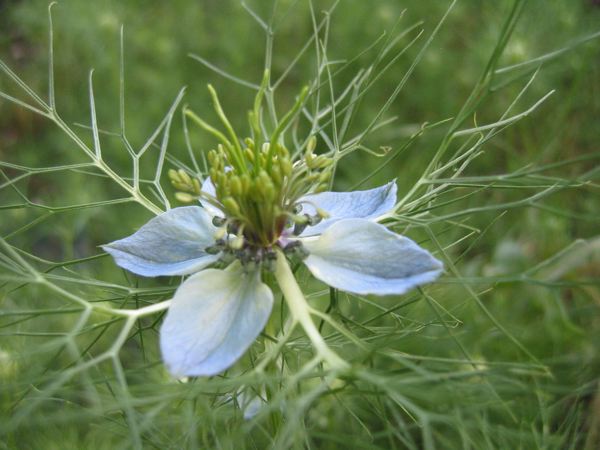Cardoons and other alien invaders.
Originally published in the Davis Enterprise May 22, 2008
What nursery professionals say: Spreads freely. Easy to grow. Naturalizes.
What gardeners say: takes over your yard!
Vigorous plants can be a gardener's friend or foe. I love a plant which fills an area with little effort on my part, such as mint. When you buy mint, I want you to be aware that you have probably just made a permanent decision. But it isn't going to take over the neighborhood − just your planter box.
Let me tell you about cardoons. A kindly customer gave me four little seedlings of this artichoke relative, commenting "watch out, it reseeds". The mid-ribs of the leaves are eaten in Italy in a variety of interesting ways (breaded and fried, dipped in hot olive oil, or baked − of course − with parmesan cheese. The first year we sampled some, and concluded it had the flavor of zucchini with the texture of celery. Then they flowered, producing lovely but inedible artichoke-like flowers: giant thistles on 8' stems! Stunning! These were followed by wind-disseminated seeds. Seedlings popped up 30 to 40 feet away, beginning a population march out into our field which we spent the next few years abating. I estimate 200 plants sprouted from those four little seedlings.
A quick review of the state ag department noxious weed list found Cardoon (Cynara cardunculus, aka artichoke thistle) on their "B" List: "eradication, containment, control, or other holding action at the discretion of the [Agricultural] Commissioner." Visit http://www.cdfa.ca.gov/, and look for Encycloweedia (no kidding!).
If you ask the average gardener to name "invasive" plants, he or she will likely mention bermudagrass or bamboo. Frustrating as these may be when established, they mostly don't reseed. So their aggressive character is local: a particular lot may be overgrown by bermudagrass, but the most common type you are battling in your yard happens to be sterile. So it isn't invading the nearby ditches and roadsides. Running bamboo may be spreading from your neighbor's yard, but that is mostly just an argument between the two of you. Bamboo flowers on multi-decade cycles and is rarely a truly invasive plant. You might encourage your neighbor to plant non-running bamboo instead: members of the genus Bambusa form tight clumps, while the better-known Phyllostachys spread freely.
Invasive is a term used by regulatory agencies such as the Department of Food and Agriculture (CDFA) and the local county Agricultural Commissioner. The state maintains lists of plants which are regulated statewide. Some plants are restricted locally at the discretion of the Ag Commissioner: nurseries in Yolo County cannot sell St. John's Wort (Hypericum perforatum) because it is a rangeland weed.
A truly invasive plant is one which spreads into native areas, displaces native plant species, damages habitat, affects fire management, or poses a threat to farming and ranching. Purple loosestrife (Lythrum salicaria) is a beautiful perennial flower that has invaded waterways across the US. A single plant can produce up to 2.7 million seeds, creating solid stands that crowd out all other plant life and the associated wildlife. The Giant Reed (Arundo donax) growing along Putah Creek (and often mistaken for bamboo), out-competes native willows for water, provides no food or habitat for wildlife, and is highly flammable.
Invasiveness is very local. As the California Invasive Plant Council puts it: "Invasive plants are by nature a regional or local problem. A plant that jumps out of the garden in one climate and habitat type may behave perfectly in another."
I recently received an email from a website visitor who wanted me to warn people that Nandina domestica, the common Heavenly bamboo, is an invasive plant. It is: in northern Florida and parts of Georgia, but not here. Lantana x camara, a subtropical with beautiful flowers, has become a serious rangeland invader in New Zealand, but is just an attractive garden plant in California. Scotch broom and gorse have become serious problems throughout northwestern California.
Baby's breath (Gypsophila paniculata) has clusters of delicate, airy-looking flowers used in arrangements, but it may be restricted in some areas (not here) as it invades bunchgrass rangelands.
Back to the good guys. Here is a sampling of plants which will spread freely in your yard, one way or another.
 Powis Castle Artemisia is a hybrid sagebrush with pleasantly medicinal-smelling foliage. Shown here in bloom (the flowers aren't conspicuous), these three plants have spread and rooted freely down a country lane with minimal irrigation. Note: there used to be some other plants in this area before the artemisia overran them!
Powis Castle Artemisia is a hybrid sagebrush with pleasantly medicinal-smelling foliage. Shown here in bloom (the flowers aren't conspicuous), these three plants have spread and rooted freely down a country lane with minimal irrigation. Note: there used to be some other plants in this area before the artemisia overran them!
 Delicate, papery blossoms in soft pink on the low-growing Mexican evening primrose (Oenothera speciosa 'Rosea') make this plant a lovely addition to dry gardens. Stems creep outward steadily, and the plant reseeds somewhat. If you mow it after the first wave of bloom, you will get a second blossoming and prevent some of the seeds from forming.
Delicate, papery blossoms in soft pink on the low-growing Mexican evening primrose (Oenothera speciosa 'Rosea') make this plant a lovely addition to dry gardens. Stems creep outward steadily, and the plant reseeds somewhat. If you mow it after the first wave of bloom, you will get a second blossoming and prevent some of the seeds from forming.
Vegetative spreaders:
- Artemisia Powis Castle. Three plants have spread together more than 30 feet along our road, irrigated about once a month. NO weeds grow through the dense stems. Soft, fern-like, grey foliage has a distinctive, pleasant but resinous aroma (common wormwood, the source of absinthe, is probably one of the parents of this hybrid).
Blue dawn flower (Ipomoea indica, formerly I. acuminata). This perennial morning glory has vivid blue flowers over a long season (plants can be seen on an arbor near Dos Coyotes restaurant in south Davis). Though it scarcely ever reseeds, a single plant can engulf anything nearby to about a 30 foot distance.
Jerusalem sage (Phlomis fruticosa). This sage relative (true sages are in the genus Salvia) has big woolly-gray leaves and great whorls of gold flowers which smell just like carnations! A single plant has sprawled outward, rooting here and there, to an area nearly 15 feet across. Easily managed by pruning just after the spring bloom.
 Mint: use it in tea, fresh or dried. Add to pot pourri, or just simmer some in a crock pot to scent the house. Spearmint (Mentha spicata, shown) grows to about 3 feet tall; peppermint to about 18 inches. Mint also spreads vigorously in all directions, so if you are limited for space plant it in a container. Cut it back severely -- to the ground, a lawn mower works fine -- after the bloom to keep it looking fresh.
Mint: use it in tea, fresh or dried. Add to pot pourri, or just simmer some in a crock pot to scent the house. Spearmint (Mentha spicata, shown) grows to about 3 feet tall; peppermint to about 18 inches. Mint also spreads vigorously in all directions, so if you are limited for space plant it in a container. Cut it back severely -- to the ground, a lawn mower works fine -- after the bloom to keep it looking fresh.
-
Mexican evening primrose (Oenothera speciosa 'Rosea', formerly O. berlandieri). This is the lovely soft-pink flowered ground cover you see blooming in some of the center dividers and park areas around Davis. Dixon residents can look for a big planting at the corner of Pitt School Road and I-80. Darker pink and pure white forms (less vigorous) are available. Easy to grow, hard to get rid of, it mostly spreads by runners but may also reseed a bit.
-
Mint (Mentha species.) Best-known are spearmint and peppermint. If you are limited for space, plant mint in containers and watch out for the ground-level stems which spread over the side of the pot. Years ago I planted a cute little 3" pot of spearmint, and it now covers about 15' along a path leading into my rose garden. The fragrance is pleasant as we bruise the leaves along the path. The flowers attract zillions of little butterflies. Annual digging keeps it from invading into the rest of the garden. Peppermint is less invasive and a lower-growing plant. Any mint makes a fine ground cover in partial shade or sun.
 The strange, lovely flowers of Love-in-a-mist (Nigella damascena) are true blue in the species form. Pink and white garden forms are also available. The papery and horned seed capsules are attractive and interesting in flower arrangements. This spring-flowering annual sprouts in fall, grows fern-like foliage through winter, and blooms in May. Remove the seed capsules if you don't want it all over your garden!
The strange, lovely flowers of Love-in-a-mist (Nigella damascena) are true blue in the species form. Pink and white garden forms are also available. The papery and horned seed capsules are attractive and interesting in flower arrangements. This spring-flowering annual sprouts in fall, grows fern-like foliage through winter, and blooms in May. Remove the seed capsules if you don't want it all over your garden!
Re-seeders:
-
Borage (Borago officinalis). One of my favorite annual flowers! The leaves smell like cucumbers, the flowers are a vivid true blue, and you can have blossoms any time of year. Seedlings pop up year-around, but are easy to chop out if they aren't wanted. An old English saying: ""To enliven the sad with a joy of a joke, Give the wine with the borage put in to soak." It also is a great way to draw bees to the garden.
- Love-in-a-Mist (Nigella). Sunset says "self-sows freely," and that's putting it mildly. This plant is all over my rose garden. But how can you dislike a plant with fern-like foliage, sky-blue flowers (pink and white also available), and bizarre papery horned seed capsules?
-
Mexican feather grass (Nassella tenuissima, formerly in the genus Stipa). A fine-textured grass with billowy seed-heads. Makes a soft mound of bright green foliage. Unlike many of the ornamental grasses on the market, this one fits nicely into small gardens. Tolerant of drought, but mostly reseeds where it has plenty of water.
-
Morning glory (Ipomoea tricolor). I have made the mistake of planting annual morning glory at every house I've lived in. I love the flowers but regret the reseeding. However, you can't beat morning glory for a quick summer cover over an ugly shed or fence.
-
Sweet alyssum (Lobularia maritima). If you've ever planted this, you'll always have it. A ground-covering annual with honey-scented flowers at any season that are strongly attractive to beneficial insects, Sweet alyssum is a useful addition to the vegetable garden or to plant around your roses. Purple and pink forms gradually reseed to white.
Boon or bane? Your choice. Forewarned, as they say, is forearmed.
For more information on invasive landscape plants and alternative selections, visit the Cal-IPC site: http://www.cal-ipc.org/
For more information on invasive aquatic plants:
http://www.ridnis.ucdavis.edu/
© 2008 Don Shor, Redwood Barn Nursery, Inc., 1607 Fifth Street, Davis, Ca 95616
www.redwoodbarn.com
Feel free to copy and distribute this article with attribution to this author.
Click here for Don's other Davis Enterprise articles
